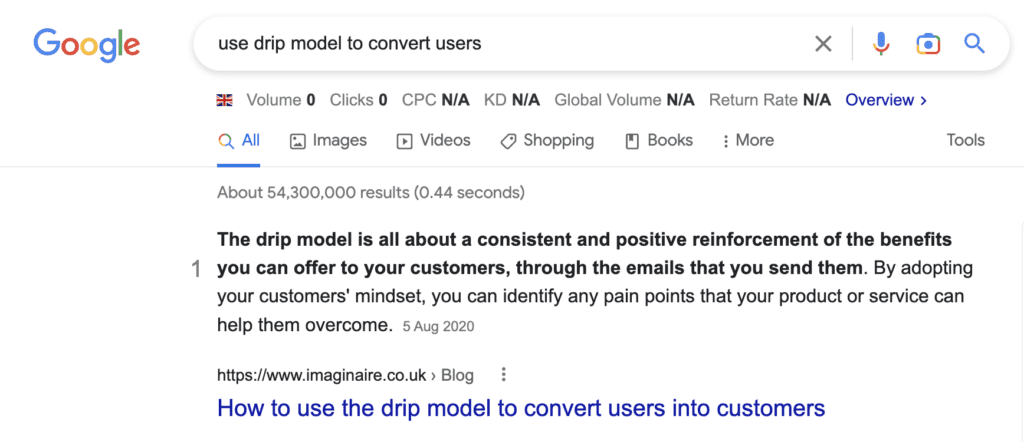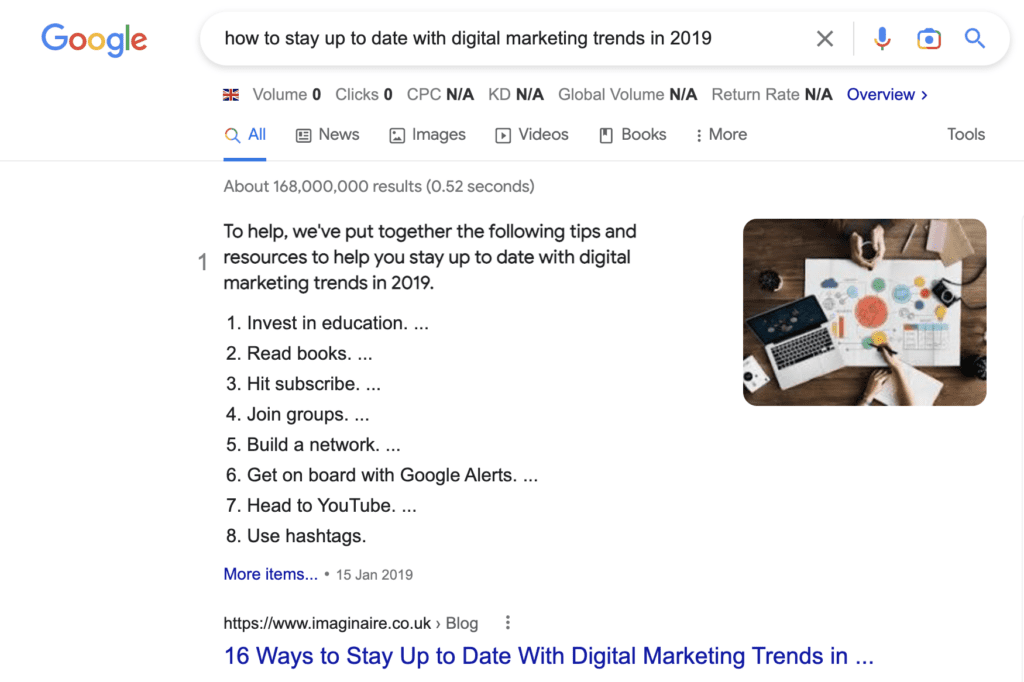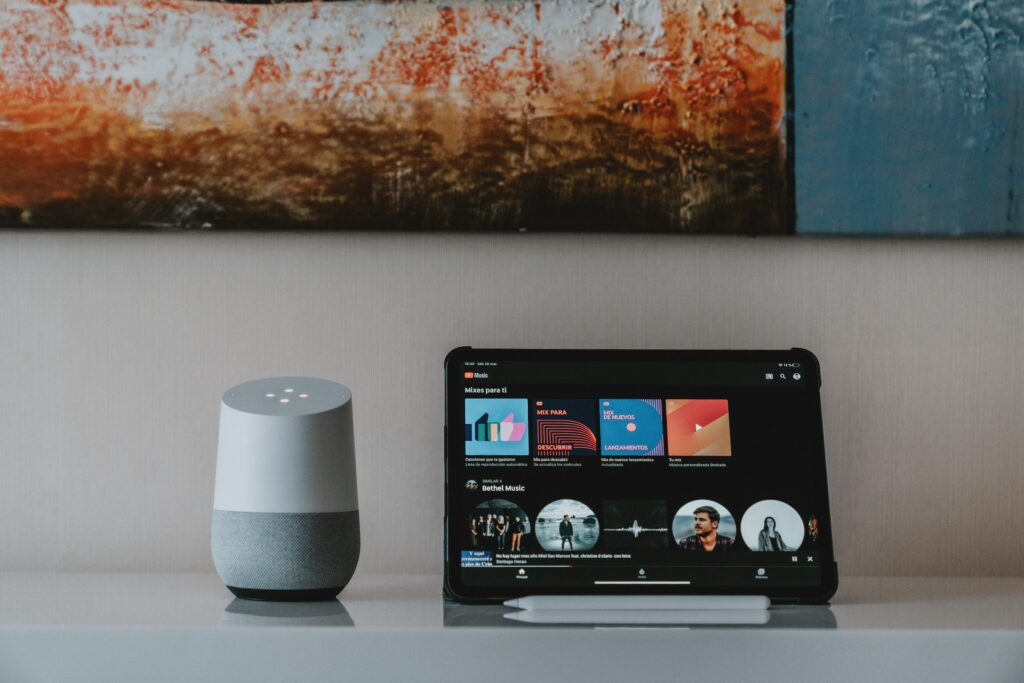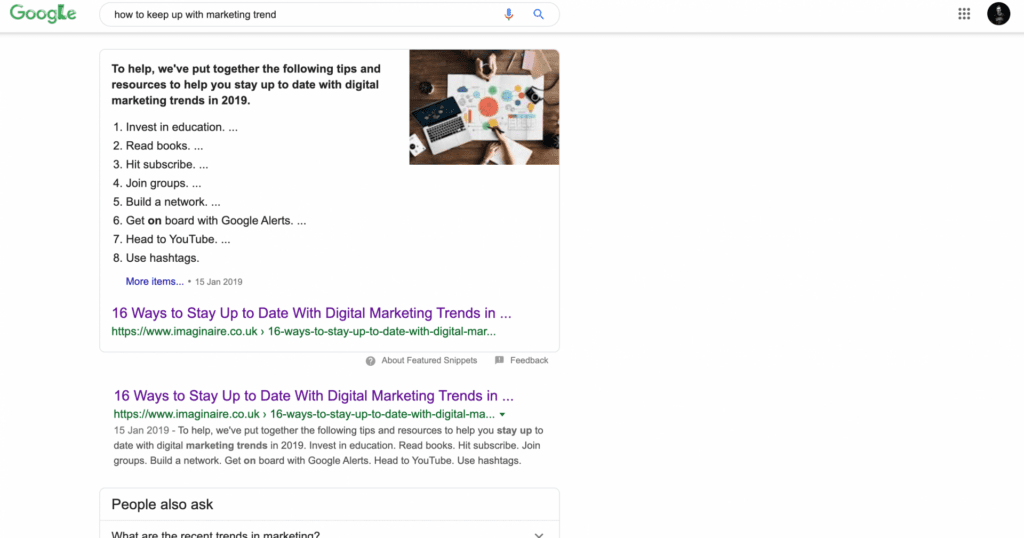Table of Contents
- Featured Snippets
- Zero-Click Searches
- Voice Search
- Relevancy to Search Intent
- Videos
- Rich Content
- Conclusion
Well, I say it every year, but Christmas really is my favourite time of the year! Not only because I get some time off work to spend with the family, eating more than any one person should and opening gifts which (most of the time) were ordered some time ago via Amazon, but it is also the time I get to sit down and look at the SEO trends I think are going to be picked up, dropped and retained for 2020.
I have spent the last 12 months using a wide array of different SEO strategies, quick wins and longer running tactics to boost my client’s rankings and increase the usefulness of their websites, with great success! However, marketers are always looking for places to improve and ways to make their success rates higher.
So, without further delay, let’s get on with Imaginaire Digital’s predictions of SEO trends for 2020 coming into the fold.
2020 SEO Trends – SERPs
Featured Snippets

Look, this isn’t new. We know featured snippets have been around for the last couple of years. However, it has taken us a while to truly figure out the best ways to get their content “featured” in Google’s ‘Position Zero’. There are a wide array of reasons as to why you may want to be listed on Google’s featured snippets, but the main one is that you will generally see an increase in click-through rates. Revered SEO guru Matthew Barby conducted a study on over 5,000 keywords where HubSpot was ranking on Page 1 where a featured snippet was being displayed. What he found was quite staggering. He found that where HubSpot was being displayed in the featured snippet, the average click-through rate was increased by over 114%!
So, how do you ensure your content has the best chance of being featured in the featured snippet? The first thing to note is that links do not matter when your content is already being ranked on Page 1, however, you should ensure your content is formatted correctly, with the keyword being displayed in at least one of the headers of your content. Using the list format on your content is also a great way to increase your chances of being listed in Google’s featured snippet, especially for ‘How-To’ style search queries. Even if your content is in longer form, you can still incorporate a list in the form of a table of contents or a “too long; didn’t read” section of the website.
Zero-Click Searches

Following on from being featured in Google’s featured snippet, another key trend we are going to see emerge in 2020 is the rise of ‘Zero-Click Searches’. These are searches performed by a user where the content on the SERP is enough to satisfy the search intent and no link is clicked. For example, if I wanted to know the rough distance between Dubai and Middlesborough to calculate a very rough journey time, I would search Google to do this. Google now has a lot of built-in tools to satisfy the user intent without a link has to be clicked.
This presents a new challenge for digital marketers. After all, the end game is to get people from the SERPs to a client’s website, and from there to conversion. That’s the “game” if you like. So a rise in zero-click searches is, of course, going to make this harder to achieve. However, there are a couple of situations where the rise in zero-click searches helps a marketer. Let me give you a scenario… You have a client who ranks Position 2 for a highly targeted keyword, but your click-through rate is incredibly low. In most instances, it is hard to point out why this is. However, if you perform the same search query and find out that Google has a built-in tool or a featured snippet that is displaying the answer that satisfies the search intent, there is no reason for a link to be clicked. From there, you can take steps to target another keyword if necessary or target your efforts on being ranked in the featured snippet.
Voice Search

I know, I know, marketers have been saying this for years! It seems as if every “SEO Trends” blog post published since the back end of 2015 has featured the words voice search. In reality, that is probably quite accurate. However, 2020 is the year it finally comes into full effect. No, I am not saying that the “50% of all searches will be performed via voice” is accurate, in fact, I don’t believe it is accurate at all. However, there are a number of very promising statistics that show voice search is clearly on the rise. Here are a few of my favourites:
- The Amazon Echo Dot was the best-selling product on Amazon in the 2018 Christmas season.
- 60% of smartphone users have tried voice search in the last 12 months.
- 55% of teenagers are using voice search on a daily basis.
The above statistics clearly show that voice search is on the rise, and the number of people using it regularly (or even daily) is increasing year after year. If marketers are intent on increasing their customer satisfaction through improved results in 2020, they need to ensure they are targeting for voice search as well.
Relevancy to Search Intent
One of the main things that is going to make or break your success in search in 2020 is your ability to understand the search intent behind your targeted keywords. Coming into this is ensuring your content is relevant to the intent of the user. One of the best examples I have heard of this is from Matthew Barby’s talk at SearchLeeds back in 2016. Here he talked about the possibility of him wanting to build a shed, then he searches for the query “how to build a shed”. He clicks on the first result he sees and is greeted with offers to “buy sheds now” as he calls is. Of course, this is a horrible user experience and is only going to increase your bounce rate.
We know, through years and years of research that if your bounce rate on a website is high then it is not going to rank anywhere near where you want it to. So it is vital you keep your bounce rate down. The simple way to do this? Ensure that the results you are showing up for are relevant to what is being searched. If someone has searched for how to build a shed, show them how to build a shed. Later, if they realise building a shed is really difficult and they want to buy one, then you can push them into your sales funnel. The chances are if you have given them good advice in the first place, they will come back to you when they need your product/s or service.
2020 SEO Trends – Content
Videos

We know videos are a huge thing for marketers for brand awareness, SEO and much more. The good news is videos are becoming more and more important every year. One of the main ways digital marketers and other SEOs can take advantage of video for SEO purposes is by converting their blog to a mainly video-based blog. How would this work? I hear you. Moz use video to an excellent standard with their ‘Whiteboard Friday‘ videos, which I personally watch every week! However, where they go further than a lot of companies would go is they add transcripts at the bottom of every video. Now, this isn’t new, I know, but it has a tremendous SEO advantage. Utilising transcripts for all videos on your website is a great way to get your keywords into a form Google understand. You can also add links and complete other SEO best practices to boost your site up the rankings.
Rich Content
Following on from the point about videos above, another medium SEOs can no longer ignore going into 2020 is the use of rich content. Now, rich content essentially means different media formats that are used on websites, such as videos, images and even GIFs. These forms of content have become more and more heavily featured on websites for the last couple of years, images and videos especially.
One of the main ways you can ensure you are utilising these forms of rich content correctly is by ensuring you are “doing the basics”. This means adding transcripts to all the videos you use on your site where spoken word features heavily (as explained above). Another way is to ensure you utilise ‘alt tags’ on all images on your site, including keywords where necessary. GIFs are a little bit of a grey area, but they can be used in a multitude of ways. For example, using them on your longer blog posts will keep readers engaged, reducing bounce rates.
Conclusion
As you can see from the above, there are a wide array of tactics and trends that we will see come to the fold in 2020. This time of year is always exciting as it allows us marketers to plan how we are going to implement these trends in the year to come to give us the best chance of success. Feel free to come back to this blog post at the end of next year to see how accurate our SEO trends for 2020!

